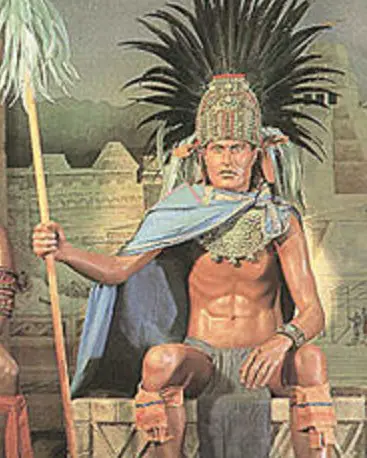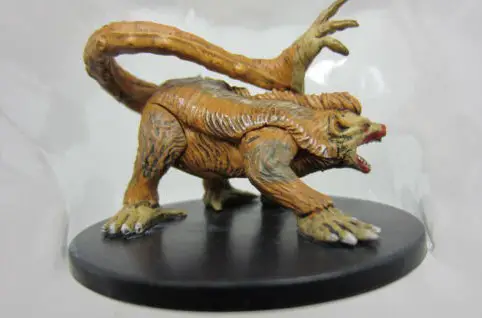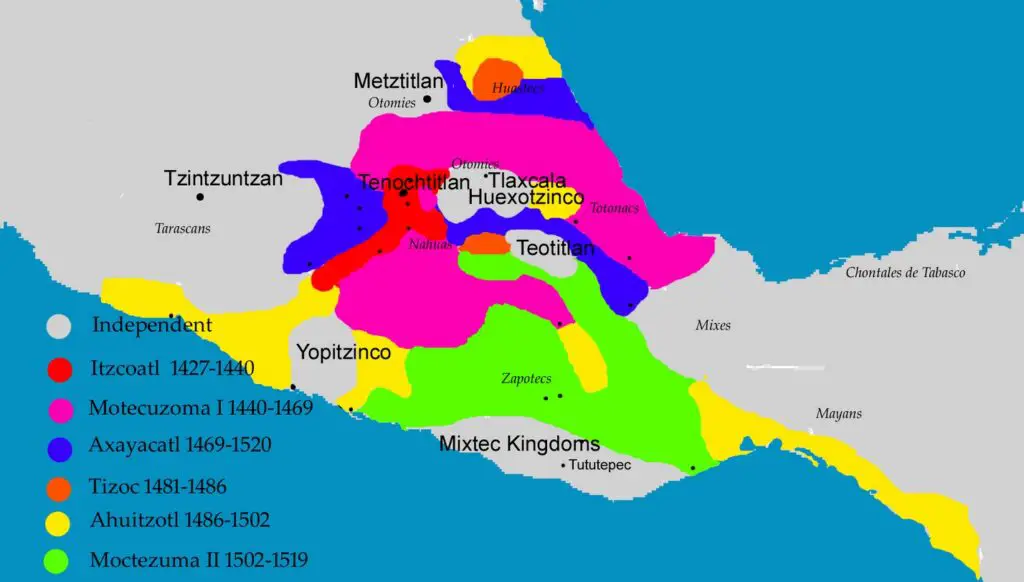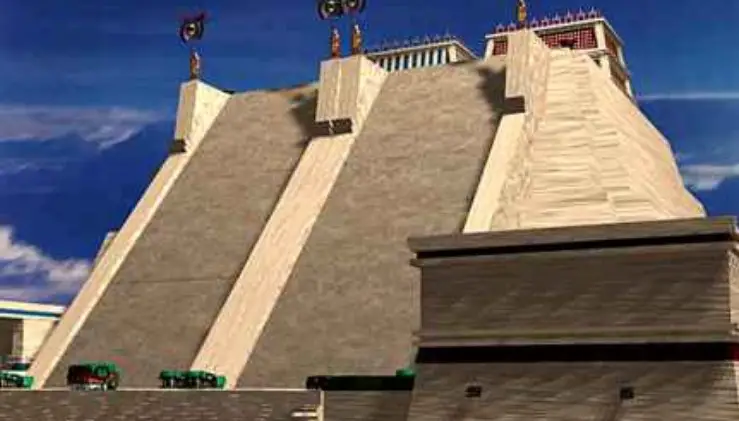Podcast: Play in new window | Download
Subscribe: Apple Podcasts | RSS
 In the year 2006 archaeologists with Mexico’s National Institute of Anthropology and History were digging at the Templo Mayor in the heart of Mexico City when they uncovered a significant monolith. On it was carved the image of a goddess holding a rabbit with 10 dots on her right foot. Scholars interpreted this to mean the year 10 Rabbit, or the year 1502 in the Western calendar. This was an important year for the Aztecs as it was when their beloved emperor Ahuizotl passed away. Researchers thought that perhaps the carved stone meant that the famous leader’s tomb was nearby. Archaeologists began using ground penetrating radar and, in a few months, discovered the location of the tomb they suspected was there. If this were the tomb of Ahuizotl, it would be the first time in history a royal Aztec burial was ever discovered. Excavation of this tomb only began in 2019, which was the 500th anniversary year of Cortés’ march on the Aztec capital of Tenochtitlan that marked the beginning of the end of the Aztec Empire. In this large stone box archaeologists found jaguar bones and the bones of a young boy who at the time of his death at around age 9 was clothed to look like Huitzilopochtli, the Aztec god of war. The boy was wearing a jade necklace and had on what was a cape or wings made from the bones of hawks. On what would have been the back of the jaguar they found an intricately carved wooden medallion, possibly also dedicated to the war god. Beneath the bones of the child and the jaguar were the bones of a roseate spoonbill, a bird from the flamingo family, long associated with Aztec warriors and the Tenochtitlan nobility. Alongside these curious finds in the sarcophagus were seashells and pieces of coral which came from the coastal waters of the Yucatán and Belize almost a thousand miles away. Researchers believe that the location of this tomb was once part of a circular ritual platform which stood in front of the twin pyramids that made up what is now called the Templo Mayor. According to accounts made by members of Cortés’ entourage at the time of the Conquest, Aztec priests deposited the cremated remains of the Aztec emperors in this circular stone platform along with elaborate offerings. By the time of the COVID-19 quarantines and lockdowns only a little more than 10% of the tomb had been excavated and studied. At the recording of this podcast excavation of this important discovery has not yet resumed. The world is left hanging with a huge question: Did archaeologists discover the final resting place of the great emperor Ahuizotl?
In the year 2006 archaeologists with Mexico’s National Institute of Anthropology and History were digging at the Templo Mayor in the heart of Mexico City when they uncovered a significant monolith. On it was carved the image of a goddess holding a rabbit with 10 dots on her right foot. Scholars interpreted this to mean the year 10 Rabbit, or the year 1502 in the Western calendar. This was an important year for the Aztecs as it was when their beloved emperor Ahuizotl passed away. Researchers thought that perhaps the carved stone meant that the famous leader’s tomb was nearby. Archaeologists began using ground penetrating radar and, in a few months, discovered the location of the tomb they suspected was there. If this were the tomb of Ahuizotl, it would be the first time in history a royal Aztec burial was ever discovered. Excavation of this tomb only began in 2019, which was the 500th anniversary year of Cortés’ march on the Aztec capital of Tenochtitlan that marked the beginning of the end of the Aztec Empire. In this large stone box archaeologists found jaguar bones and the bones of a young boy who at the time of his death at around age 9 was clothed to look like Huitzilopochtli, the Aztec god of war. The boy was wearing a jade necklace and had on what was a cape or wings made from the bones of hawks. On what would have been the back of the jaguar they found an intricately carved wooden medallion, possibly also dedicated to the war god. Beneath the bones of the child and the jaguar were the bones of a roseate spoonbill, a bird from the flamingo family, long associated with Aztec warriors and the Tenochtitlan nobility. Alongside these curious finds in the sarcophagus were seashells and pieces of coral which came from the coastal waters of the Yucatán and Belize almost a thousand miles away. Researchers believe that the location of this tomb was once part of a circular ritual platform which stood in front of the twin pyramids that made up what is now called the Templo Mayor. According to accounts made by members of Cortés’ entourage at the time of the Conquest, Aztec priests deposited the cremated remains of the Aztec emperors in this circular stone platform along with elaborate offerings. By the time of the COVID-19 quarantines and lockdowns only a little more than 10% of the tomb had been excavated and studied. At the recording of this podcast excavation of this important discovery has not yet resumed. The world is left hanging with a huge question: Did archaeologists discover the final resting place of the great emperor Ahuizotl?
 In the time before that question can be answered, perhaps we can ask another important question: who was Ahuizotl? The future emperor was born at the royal palace in Tenochtitlan sometime in the late 1460s. He was named after the legendary lake monster said to have inhabited Lake Texcoco. For more information about this Mexican cryptid, please see Mexico Unexplained Episode 89 https://mexicounexplained.com/tales-mexican-lake-monsters/ Ahizotl’s mother was Princess Atototzli sometimes referred to in the history books as Huitzilxochtzin. The princess was the daughter of Montezuma the First, who was the second Aztec emperor and the fifth king of Tenochtitlan. Through her mother the princess was descended from the ruling family of the Kingdom of Cuahunahuac which was later renamed Cuernavaca. Ahuizotl’s father was Tezozomoc whose father was Aztec Emperor Itzcoatl. During his lifetime while technically the leader of the Aztecs, Tezozomoc never assumed the title of Emperor or tlatoani, because his wife outranked him by blood. In this complicated household, Ahuizotl was the third of three brothers. His older brothers were Axayacatl and Tizoc, who both became Aztec emperors. Ahuizotl also had a sister whose Aztec name, Chalchiuhnenetzin, in English means “Noble Jade Doll.” Chalchiuhnenetzin rose from the rank of princess to that of queen when she married the King of Tlatelolco, a wealthy and powerful man named Moquihix. History records Ahuizotl’s sister as being very tall and very slender, much like a supermodel of today. Apparently, the King of Tlatelolco treated Ahuizotl’s sister terribly and this was one of the reasons why their older brother, Axayacatl, when he was Aztec emperor, conquered the Kingdom of Tlatelolco and executed King Moquihix. This conquest happened in the year 1473 when Ahuizotl was still a boy. As a young man the future emperor Ahuizotl experienced the drama of his extended family and all the intrigues of court life at the Aztec capital of Tenochtitlan. In the year 1480 Ahuizotl’s older brother Emperor Axayacatl became seriously ill and died the next year. The second of the three brothers, Tizoc, then became emperor of the Aztecs in 1481. Tizoc had a short reign, only 5 years, but during that time he accomplished a great deal. The Aztecs conquered and incorporated 14 different independent kingdoms into their empire and construction began on the Templo Mayor. Some sources describe Tizoc as “sickly” and use this as a reason for why he passed away at a young age. Others claim that Tizoc was poisoned to make way for his younger brother, Ahuizotl, to assume the title of tlatoani and rule over the vast Aztec Empire.
In the time before that question can be answered, perhaps we can ask another important question: who was Ahuizotl? The future emperor was born at the royal palace in Tenochtitlan sometime in the late 1460s. He was named after the legendary lake monster said to have inhabited Lake Texcoco. For more information about this Mexican cryptid, please see Mexico Unexplained Episode 89 https://mexicounexplained.com/tales-mexican-lake-monsters/ Ahizotl’s mother was Princess Atototzli sometimes referred to in the history books as Huitzilxochtzin. The princess was the daughter of Montezuma the First, who was the second Aztec emperor and the fifth king of Tenochtitlan. Through her mother the princess was descended from the ruling family of the Kingdom of Cuahunahuac which was later renamed Cuernavaca. Ahuizotl’s father was Tezozomoc whose father was Aztec Emperor Itzcoatl. During his lifetime while technically the leader of the Aztecs, Tezozomoc never assumed the title of Emperor or tlatoani, because his wife outranked him by blood. In this complicated household, Ahuizotl was the third of three brothers. His older brothers were Axayacatl and Tizoc, who both became Aztec emperors. Ahuizotl also had a sister whose Aztec name, Chalchiuhnenetzin, in English means “Noble Jade Doll.” Chalchiuhnenetzin rose from the rank of princess to that of queen when she married the King of Tlatelolco, a wealthy and powerful man named Moquihix. History records Ahuizotl’s sister as being very tall and very slender, much like a supermodel of today. Apparently, the King of Tlatelolco treated Ahuizotl’s sister terribly and this was one of the reasons why their older brother, Axayacatl, when he was Aztec emperor, conquered the Kingdom of Tlatelolco and executed King Moquihix. This conquest happened in the year 1473 when Ahuizotl was still a boy. As a young man the future emperor Ahuizotl experienced the drama of his extended family and all the intrigues of court life at the Aztec capital of Tenochtitlan. In the year 1480 Ahuizotl’s older brother Emperor Axayacatl became seriously ill and died the next year. The second of the three brothers, Tizoc, then became emperor of the Aztecs in 1481. Tizoc had a short reign, only 5 years, but during that time he accomplished a great deal. The Aztecs conquered and incorporated 14 different independent kingdoms into their empire and construction began on the Templo Mayor. Some sources describe Tizoc as “sickly” and use this as a reason for why he passed away at a young age. Others claim that Tizoc was poisoned to make way for his younger brother, Ahuizotl, to assume the title of tlatoani and rule over the vast Aztec Empire.
 Ahuizotl became emperor in the year 7 Rabbit, or 1486. Some sources say he was about 17 or 18 years old when he was declared the supreme ruler of the Aztecs. It is assumed that as a boy he participated in some of the military campaigns of his older brothers and was skilled in the art of war. Some history books even declare Ahuizotl to be the greatest military commander who ever lived in the ancient Americas. This young emperor’s warrior sensibilities were so fine-tuned that the Aztec Empire almost doubled in size during Ahuizotl’s reign. Within months of assuming power, the young emperor had his first test. A quasi-tributary state associated with the Aztec Empire – the Huastec Kingdom – rebelled against royal authority and stopped sending tribute to Tenochtitlan. Ahuizotl led a massive army to the northern frontier and not only crushed the rebellion, but he also incorporated all territory of the Huastecs into the Aztec Empire. This expanded the Aztec realm far to the north into what is now the modern Mexican state of Tamaulipas. The Huastecs had been a buffer state between the Aztecs and the warlike and nomadic Chichimeca people discussed in Mexico Unexplained episode number 142 https://mexicounexplained.com/chichimeca-warriors-of-the-north/ After conquering the Huastecs, the armies of the Aztecs were faced with confronting the Chichimeca directly on their northern frontier. When Ahuizotl returned to Tenochtitlan victorious in his campaign against the Huastecs, he got to work on finishing the improvements to the capital city that his brother Emperor Tizoc had started. The most significant of these projects was the expansion of the Templo Mayor which was finished within the first two years of Ahuizotl’s reign. Another major project was the building of a canal and aqueduct system that would bring fresh water to Tenochtitlan from Coyoacan. This water delivery system almost worked too well as it brought so much fresh water to the heart of the capital city that it caused flooding. Priests and others blamed the flooding on the fact that Ahuizotl had killed the king of Coyoacan and this was the revenge of the gods. Whatever the reason for the overabundance of water, Aztec engineers figured out the problem and managed to ensure a steady and controllable flow of fresh water to quench the thirst of an ever-growing Tenochtitlan. After the conquests of the north, Ahuizotl looked south. For many years the Aztecs had influence over the rich land located near the present-day border of Mexico and Guatemala called Xoconochco or Soconusco and was connected to this far-flung territory by time-worn overland trade routes. Ahuizotl sent his armies almost 800 miles to this remote area to conquer it and establish permanent Aztec forts and settlements there. For more details about Ahuiztol’s conquest of Xoconochco, please see Mexico Unexplained episode 162: https://mexicounexplained.com/xoconochco-the-remotest-aztec-province/ During his reign Ahuizotl also conquered the Mixtecs and Zapotecs. In addition, he skirted around the Tarascan Empire subjugating the small kingdoms to the south of the Tarascans and thus pushed the Aztec Empire to the Pacific coast. Ahuizotl’s armies had many minor border wars and skirmishes with the military of the Tarascan State, but like the Chichimeca, the Aztecs never conquered the Tarascans. As a result of all this conquest and subjugation, not only did the territory of the Aztec Empire double under Ahuizotl, but the wealth from these various conquered regions also poured into the Aztec capital thus making the city incredibly wealthy. The rulers used the wealth for more civic improvements to Tenochtitlan including grander temples and other monumental public works projects. Things like art and poetry flourished in the Aztec capital. Historians often refer to Ahuizotl’s reign as the “Aztec Golden Age.” It is important to note that while many people may glorify this time in ancient Mexican history, and many Mexican-Americans in particular may feel a sense of pride in this Aztec past, like many empires the world over, the glory days were the result of colonization, exploitation and subjugation of other peoples. While the streets of Tenochtitlan bloomed with an overabundance of flowers from perfectly manicured hanging gardens, in other parts of the empire villages were scrounging around desperately to meet the demands of the Aztec tax collectors or face imminent death. History is always more complex and nuanced than most people think.
Ahuizotl became emperor in the year 7 Rabbit, or 1486. Some sources say he was about 17 or 18 years old when he was declared the supreme ruler of the Aztecs. It is assumed that as a boy he participated in some of the military campaigns of his older brothers and was skilled in the art of war. Some history books even declare Ahuizotl to be the greatest military commander who ever lived in the ancient Americas. This young emperor’s warrior sensibilities were so fine-tuned that the Aztec Empire almost doubled in size during Ahuizotl’s reign. Within months of assuming power, the young emperor had his first test. A quasi-tributary state associated with the Aztec Empire – the Huastec Kingdom – rebelled against royal authority and stopped sending tribute to Tenochtitlan. Ahuizotl led a massive army to the northern frontier and not only crushed the rebellion, but he also incorporated all territory of the Huastecs into the Aztec Empire. This expanded the Aztec realm far to the north into what is now the modern Mexican state of Tamaulipas. The Huastecs had been a buffer state between the Aztecs and the warlike and nomadic Chichimeca people discussed in Mexico Unexplained episode number 142 https://mexicounexplained.com/chichimeca-warriors-of-the-north/ After conquering the Huastecs, the armies of the Aztecs were faced with confronting the Chichimeca directly on their northern frontier. When Ahuizotl returned to Tenochtitlan victorious in his campaign against the Huastecs, he got to work on finishing the improvements to the capital city that his brother Emperor Tizoc had started. The most significant of these projects was the expansion of the Templo Mayor which was finished within the first two years of Ahuizotl’s reign. Another major project was the building of a canal and aqueduct system that would bring fresh water to Tenochtitlan from Coyoacan. This water delivery system almost worked too well as it brought so much fresh water to the heart of the capital city that it caused flooding. Priests and others blamed the flooding on the fact that Ahuizotl had killed the king of Coyoacan and this was the revenge of the gods. Whatever the reason for the overabundance of water, Aztec engineers figured out the problem and managed to ensure a steady and controllable flow of fresh water to quench the thirst of an ever-growing Tenochtitlan. After the conquests of the north, Ahuizotl looked south. For many years the Aztecs had influence over the rich land located near the present-day border of Mexico and Guatemala called Xoconochco or Soconusco and was connected to this far-flung territory by time-worn overland trade routes. Ahuizotl sent his armies almost 800 miles to this remote area to conquer it and establish permanent Aztec forts and settlements there. For more details about Ahuiztol’s conquest of Xoconochco, please see Mexico Unexplained episode 162: https://mexicounexplained.com/xoconochco-the-remotest-aztec-province/ During his reign Ahuizotl also conquered the Mixtecs and Zapotecs. In addition, he skirted around the Tarascan Empire subjugating the small kingdoms to the south of the Tarascans and thus pushed the Aztec Empire to the Pacific coast. Ahuizotl’s armies had many minor border wars and skirmishes with the military of the Tarascan State, but like the Chichimeca, the Aztecs never conquered the Tarascans. As a result of all this conquest and subjugation, not only did the territory of the Aztec Empire double under Ahuizotl, but the wealth from these various conquered regions also poured into the Aztec capital thus making the city incredibly wealthy. The rulers used the wealth for more civic improvements to Tenochtitlan including grander temples and other monumental public works projects. Things like art and poetry flourished in the Aztec capital. Historians often refer to Ahuizotl’s reign as the “Aztec Golden Age.” It is important to note that while many people may glorify this time in ancient Mexican history, and many Mexican-Americans in particular may feel a sense of pride in this Aztec past, like many empires the world over, the glory days were the result of colonization, exploitation and subjugation of other peoples. While the streets of Tenochtitlan bloomed with an overabundance of flowers from perfectly manicured hanging gardens, in other parts of the empire villages were scrounging around desperately to meet the demands of the Aztec tax collectors or face imminent death. History is always more complex and nuanced than most people think.
 Emperor Ahuizotl left behind quite a legacy when he died in the year 10 Rabbit, or 1502 on the Western calendar. There are conflicting stories as to how this famous Aztec ruler died. Some believe he was poisoned, but that is a common reason cited for death among many of the Aztec leaders, including Ahuizotl’s own brother Tizoc. In another story, which is the one more preferred by historians, Tenochtitlan was undergoing some minor flooding and unknown to Emperor Ahuizotl some of the floors of the imperial palace were covered in small amounts of water. The emperor supposedly slipped on a wet floor and hit his head on a stone lintel, killing him instantly. He was barely in his early 40s when he passed. Although he had two sons and a daughter, in 1502 the title of tlatoani or emperor passed to his nephew who would rule under the name of Montezuma the Second. 17 years into his reign this unlucky nephew would have the misfortune of being on the throne when the Spanish arrived. One can only wonder what would have happened to the Aztecs if Emperor Ahuizotl hadn’t slipped on the wet floor on that fateful day in 1502. It would have been quite possible that Cortés would have been dealing with a wiser and more seasoned Ahuizotl – who would have been in his late 50s – instead of his nephew Montezuma. Would the outcome have been any different? We will leave that to the theoretical historians and the daydreamers.
Emperor Ahuizotl left behind quite a legacy when he died in the year 10 Rabbit, or 1502 on the Western calendar. There are conflicting stories as to how this famous Aztec ruler died. Some believe he was poisoned, but that is a common reason cited for death among many of the Aztec leaders, including Ahuizotl’s own brother Tizoc. In another story, which is the one more preferred by historians, Tenochtitlan was undergoing some minor flooding and unknown to Emperor Ahuizotl some of the floors of the imperial palace were covered in small amounts of water. The emperor supposedly slipped on a wet floor and hit his head on a stone lintel, killing him instantly. He was barely in his early 40s when he passed. Although he had two sons and a daughter, in 1502 the title of tlatoani or emperor passed to his nephew who would rule under the name of Montezuma the Second. 17 years into his reign this unlucky nephew would have the misfortune of being on the throne when the Spanish arrived. One can only wonder what would have happened to the Aztecs if Emperor Ahuizotl hadn’t slipped on the wet floor on that fateful day in 1502. It would have been quite possible that Cortés would have been dealing with a wiser and more seasoned Ahuizotl – who would have been in his late 50s – instead of his nephew Montezuma. Would the outcome have been any different? We will leave that to the theoretical historians and the daydreamers.
REFERENCES
Online Encyclopedia Britannica, Wikipedia and INAH website (in Spanish)
